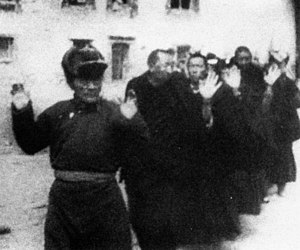| 1959 Tibetan uprising | |||||||
|---|---|---|---|---|---|---|---|
| Part of the Cold War | |||||||
 Tsarong Dazang Dramdul and several Tibetan monks captured by the PLA during the uprising | |||||||
| |||||||
| Belligerents | |||||||
|
Simultaneous rebellion in Kham and Amdo:
| |||||||
| Commanders and leaders | |||||||
| Several leaders[1] | Tan Guansan | ||||||
| Casualties and losses | |||||||
| 85,000–87,000 casualties (TGIE claim) | 2,000 killed | ||||||
| 1959 Tibetan uprising | |||||||
|---|---|---|---|---|---|---|---|
| Traditional Chinese | 1959年西藏起義 | ||||||
| Simplified Chinese | 1959年西藏起义 | ||||||
| |||||||
| 1959 Tibetan armed rebellion | |||||||
| Traditional Chinese | 1959年西藏武裝叛亂 | ||||||
| Simplified Chinese | 1959年西藏武装叛乱 | ||||||
| |||||||
| 1959 Tibetan anti-riot movement | |||||||
| Traditional Chinese | 1959年西藏抗暴運動 | ||||||
| Simplified Chinese | 1959年西藏抗暴运动 | ||||||
| |||||||
| 1959 Tibetan unrests | |||||||
| Traditional Chinese | 1959年藏區騷亂 | ||||||
| Simplified Chinese | 1959年藏区骚乱 | ||||||
| |||||||
| History of Tibet |
|---|
 |
| See also |
|
|
The 1959 Tibetan uprising (also known by other names) began on 10 March 1959, when a revolt erupted in Lhasa, the capital of Tibet, which had been under the effective control of the People's Republic of China (PRC) since the Seventeen Point Agreement was reached in 1951.[2] The initial uprising occurred amid general Chinese-Tibetan tensions and a context of confusion, because Tibetan protesters feared that the Chinese government might arrest the 14th Dalai Lama. The protests were also fueled by anti-Chinese sentiment and separatism.[3][4][5][6][7] At first, the uprising mostly consisted of peaceful protests, but clashes quickly erupted and the Chinese People's Liberation Army (PLA) eventually used force to quell the protests. Some of the protesters had captured arms. The last stages of the uprising included heavy fighting, with high civilian and military losses. The 14th Dalai Lama escaped from Lhasa, while the city was fully retaken by Chinese security forces on 23 March 1959. Thousands of Tibetans were killed during the 1959 uprising, but the exact number of deaths is disputed.
Earlier in 1956, armed conflict between Tibetan guerrillas and the PLA started in the Kham and Amdo regions, which had been subjected to socialist reform. The guerrilla warfare later spread to other areas of Tibet and lasted through 1962. Some regard the Xunhua Incident in 1958 as a precursor of the Tibetan uprising.[8][9]
The annual 10 March anniversary of the uprising is observed by exiled Tibetans as Tibetan Uprising Day and Women's Uprising Day.[10] On 19 January 2009, The PRC-controlled legislature in the Tibet Autonomous Region chose 28 March as the national anniversary of Serfs Emancipation Day. American Tibetologist Warren W. Smith Jr. describes the move as a "counter-propaganda" celebration following the 10 March 2008 unrest in Tibet.[11]
Cite error: There are <ref group=lower-alpha> tags or {{efn}} templates on this page, but the references will not show without a {{reflist|group=lower-alpha}} template or {{notelist}} template (see the help page).
- ^ Van Schaik 2013, p. 234: "Meanwhile, the crowd outside the Norbulingka was beginning to appoint representatives and a leadership was emerging, drawn from the ordinary people rather than the aristocracy. Sixty of these representatives were invited inside, and the Dalai Lama’s message was relayed to them."
- ^ Jian 2006.
- ^ Van Schaik 2013, p. 234.
- ^ Shakya 1999, pp. 186–191.
- ^ Robin 2020, p. 13.
- ^ Croddy 2022, p. 687.
- ^ Guyot-Réchard 2017, pp. 165, 172.
- ^ Li, Jianglin (2016). Tibet in Agony. Harvard University Press. ISBN 978-0-674-97370-1.
- ^ Luo, Siling (22 June 2016). "西藏的秘密战争,究竟发生了什么?(下)". The New York Times (in Chinese). Archived from the original on 3 March 2021. Retrieved 15 July 2020.
- ^ Gyatso, His Holiness the 14th Dalai Lama, Tenzin (18 November 2011). "The Genesis Of The Tibetan Women's Struggle For Independence". tibetanwomen.org. Tibetan Women’s Association. Archived from the original on 30 January 2019. Retrieved 30 January 2019.
{{cite web}}: CS1 maint: numeric names: authors list (link) - ^ Norbu, Jamyang (20 March 2009). "Warren Smith on "Serf Emancipation Day"". Shadow Tibet. Archived from the original on 2 April 2015. Retrieved 10 March 2021.